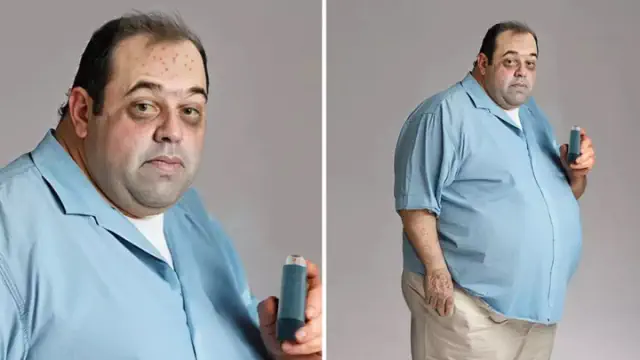State legislators have broadened the legislation regarding medical release for incarcerated individuals, though the criteria for eligibility continue to be restrictive.

View pictures in App save up to 80% data.
This story first appeared in Bolts, and is reprinted with permission.
“An inmate told me that one physician estimated I had two to four years remaining,” said 64-year-old James Davis, his deep southern drawl evident. “Another claimed three to five. The truth is, they can’t really tell. But one thing is certain: if I stay here, cancer will take me out while I’m locked up.”
Davis, a tall Caucasian man with fine brown hair and a long gray beard, is currently serving a prison term of 31 to 35 years in North Carolina due to a tragic truck accident that resulted in the deaths of an elderly couple and left their adult daughter with serious injuries in 2007. One night, Davis lost control of his flatbed Ford F-350, crashing into the side of the family's smaller Chevy S-10 pickup. After the incident, he was found to have a blood alcohol level of 0.09 at the hospital, exceeding the legal limit of 0.08. This resulted in two consecutive convictions for second-degree murder, which account for the majority of his lengthy sentence.
In 2019, doctors identified Davis as having prostate cancer. After undergoing radiation therapy, he achieved remission; however, in 2022, the cancer reemerged, metastasizing to his ribs, collarbone, pelvis, and lymph nodes.
“It’s stage four,” Davis remarked from a dayroom at Neuse Correctional, a medium-security facility in Goldsboro, North Carolina. He also battles Type-2 diabetes, osteoporosis, arthritis, and hypertension. To hear conversations, he has to lean in with his hand cupped around his ear. Mobility is a challenge, requiring the assistance of a wheeled walker. His very presence seems to embody struggle and pain. “At this stage, they’re not aiming to cure me. I’ve passed that point. They’re just managing my care until the end.”
Struggling with an expensive medical bill
Davis is just one of about 31,000 North Carolina prisoners who racked up a $357.4 million bill for health care in fiscal year 2021-2022, an expenditure that ballooned 51 percent over the past 10 years, according to NC Health News. Nationally, U.S. prisons spent $8.1 billion on prison health care in 2015 alone, as reported by Pew Trusts.
In 2023, the Republican-controlled legislature in North Carolina enacted reforms aimed at lowering the expenses associated with prison health care, easing the criteria for early medical releases. This legislation was signed into law by Governor Roy Cooper, a Democrat who concluded his term at the end of December.
In North Carolina's medical release program, medical personnel from the prison or representatives of an inmate, including family members or attorneys, have the ability to request an evaluation for medical release from prison officials. Should the officials find that the individual qualifies under the specified criteria, they have the authority to forward the case to the parole commission, which is appointed by the governor, for a conclusive decision.
The recent modifications have adjusted the age threshold for prisoners eligible for medical release from 65 to 55. To be considered, a prisoner must be critically ill, disabled, or elderly to the point of being medically incapacitated and assessed by authorities as not posing a threat to public safety. Additionally, they must have no more than nine months remaining on their sentence, in contrast to the previous requirement of being within six months of their release date. However, individuals convicted of murder, sexual offenses, and other violent crimes are still ineligible to apply.
Due to his convictions for second-degree murder stemming from a truck accident, Davis is barred from applying for medical release in North Carolina. Additionally, the length of his remaining sentence further disqualifies him. Consequently, he will continue to serve his time in prison, leading to significant costs for medical care and medications, which are ultimately covered by taxpayers. Despite these barriers, Davis expresses a desire to be considered for medical release, stating, "Because I’m dying."
Other states have medical release programs, and most codify variations of the same guidelines. All exclude people condemned to death row. On paper, New York allows infirm people convicted of anything besides murder to apply for release if they have served at least half of their sentence, yet prison officials routinely deny hearings for them to make their case. In Wisconsin, people with terminal illness whose sentences allow for parole can seek release after serving 10 years. Florida reserves the right to re-incarcerate someone previously released for medical reasons if doctors determine that their physical condition has improved.
An aging inmate demographic
The increase in life sentences that followed a wave of so-called tough-on-crime policies in the 1980s and 1990s has resulted in a graying of the U.S. prison population, leading to swelling medical costs that states are now struggling to address. As reported in the New York Times, the number of people aged 55 or older in state prisons increased by 400 percent between 1993 and 2013. That group will make up one-third of the nation’s prison population by 2030. Since 1976, the Supreme Court has considered the denial of health care to sick prisoners a violation of the 8th Amendment, regardless of whether they are serving six months or condemned to death row.
In North Carolina, too, around 17 percent of state prisoners are over 55. Those older people already cost the state four times what it spends on younger individuals, according to research published in the National Library of Medicine.
Even with broadened eligibility, the number of releases continues to be limited.
Sandra Hardee, Secretary of NC-CURE, helped push lawmakers to expand North Carolina’s medical release law in 2023, lobbying alongside other groups like the North Carolina Justice Center and Conservatives for Criminal Justice Reform.
Hardee mentioned that the financial savings that legislators anticipated from broadening medical release were crucial for their approval of the new legislation. "Prior to the enactment of the new law," Hardee stated, "the annual healthcare expenses for certain inmates reached $1 million."
Reports from the North Carolina Department of Adult Correction (DAC) indicate a notable decline in the number of individuals referred for medical release from prisons in recent years. In 2021, there were 39 referrals made to the parole commission, resulting in 29 medical releases. However, in 2022, the number of referrals plummeted to just 10, with only seven individuals receiving medical release approval. The trend continued in 2023, where only eight individuals were referred to the parole commission; three were granted medical release, one was denied, and four others passed away while waiting for a decision.
DAC has not yet published its report detailing the first year of broadened eligibility.
While Hardee appreciates that lawmakers have broadened the criteria for medical release eligibility, she notes that significant obstacles remain in the way of actually freeing terminally ill individuals who meet the requirements.
Currently, there is no designated individual or committee responsible for identifying prisoners who qualify for medical release. This lack of oversight means that inmates must navigate the application process independently. If their families cannot afford legal assistance or lack external support, these prisoners are left to complete the necessary paperwork by hand. Additionally, some inmates may be too ill to submit a request without assistance.
“Currently, there are approximately 1,000 individuals who meet the qualifications based on their age and criminal history,” Hardee stated. “Releasing them would represent progress, but identifying these individuals is not feasible.”
Yvette Garcia Missri, the executive director of the Wilson Center for Science and Justice at Duke University's law school, was instrumental in advocating for the 2023 modifications to medical release policies. Despite the broadened criteria for eligibility, Garcia Missri points out that not everyone who qualifies is actually granted release. She noted that prison authorities appear to prioritize the release of individuals who are "terminally ill," often overlooking others who may be classified as "geriatric" or "permanently ill."
“An important objective we have is to explore how we can collaborate with DAC to ensure that the law is utilized to its fullest extent, making sure everyone is accounted for,” stated Garcia Missri. A significant aspect of this objective involves clarifying essential terms in the legislation, like “medically incapacitated.” “At present, this term is subject to DAC's interpretation, which could lead to exclusion,” Garcia Missri explained. If individuals are not deemed medically incapacitated beyond mere survival, they might not qualify for early release. She is optimistic that providing precise definitions of the law’s stipulations will alleviate restrictions, thereby decreasing the number of individuals who are excluded.
Younger inmates not included.
In addition to the difficulties associated with obtaining release, the new legislation will only serve a small portion of the inmate population. Its restrictions leave out younger inmates, including those who have significant medical requirements.
In 2015, Michael Helms, then 22 years old, received a diagnosis of Crohn's disease, a chronic condition characterized by inflammation of the gastrointestinal tract, leading to severe cramps and diarrhea. Having been convicted as a teenager, Helms was already several years into a 28-year sentence for second-degree murder and conspiracy to commit murder.
“[Crohn’s] is serious,” Helms remarked as he sat in the yard of Nash Correctional, a medium-security prison located in Nashville, North Carolina. “I consider myself fortunate to be on the appropriate medication. Otherwise, bacteria might have leaked from my intestines and led to sepsis.”
This year, Fox News labeled sepsis a top killer behind heart disease and cancer, taking the lives of “350,000 American adults each year.”
Helms is still quite young, and according to the criteria set by the new legislation, he remains too healthy and his murder conviction is deemed too severe to qualify him for a medical release.
For treatment, prison nurses administer Helms one shot of Humira bi-weekly, but it’s not cheap. At nearly $4,000 a month, Helms’ treatment has already cost taxpayers about $600,000 since his diagnosis nine years ago. His treatment will cost another $720,000 before his projected release in 2040, totaling $1.3 million throughout his incarceration. That figure is added to the $133 it costs to incarcerate one person per day in the state, as noted by the DAC.
At 31 years old, Helms is in good health and dedicated to making positive changes in his life. If he had faced conviction three decades earlier, his spotless record in prison would have likely aided his chances for parole, allowing him to secure his release and manage his medical expenses. However, North Carolina abolished parole in 1994 with the introduction of the Structured Sentencing Act, which established a sentencing framework mandating an 85 percent minimum time served for all active prison terms.
A report published on JSTOR credits mandatory minimum sentencing as responsible for a spike in the national prison population. Earlier this year, the North Carolina Sentencing and Policy Advisory Commission projected that, on average, people imprisoned under the Structured Sentencing Act “will serve 104% of their minimum active sentences,” keeping prisons full of people who will cost more to care for as they age.
James Davis is not facing a life sentence without the possibility of release; he actually has a set date for when he can be freed. Had he been in better health and younger, he could have expected to live until 2039, which is when he qualifies for release. Alternatively, if the judge had opted for concurrent sentencing, his sentences would have overlapped, allowing him to be released by 2025 after completing his longest term. Unfortunately, Davis is now required to stay in prison for the rest of his life.
Despite Davis's terminal cancer diagnosis, he understands that he does not qualify for medical release. He has chosen not to take legal action against the state regarding the new law's exclusionary provisions. His decision is partly influenced by his own feelings of guilt.
“Two lives were lost, and I can’t help but feel responsible,” he confessed, leaning heavily on his walker. “I’ve been here for 16 long years. I’ve lost my father, my wife, my brother; so many loved ones are gone, and I truly grasp the hurt I’ve inflicted,” he continued, bowing his head in reflection. When he lifted it once more, tears shimmered in his weary eyes. “I wish it had been me in that accident. Not them.”










